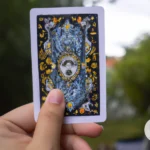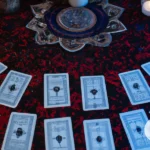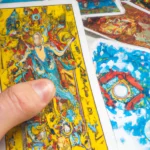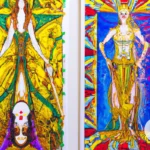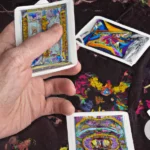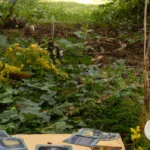As human beings, we often seek guidance and insight into different aspects of our lives. One way we do this is through divination, and tarot cards have been a popular tool for centuries. The Wild Unknown Tarot deck is a beautiful and intricate deck that has gained popularity in recent years. However, as a beginner, reading with this deck might seem overwhelming at first. How do you shuffle the cards? What do the symbols mean? Do you follow the book meanings or rely on intuition? Fear not, for this article will guide you step-by-step on how to read with the Wild Unknown Tarot deck, including advanced techniques and tips on how to cleanse and store your deck.
Getting Started with Wild Unknown Tarot Deck
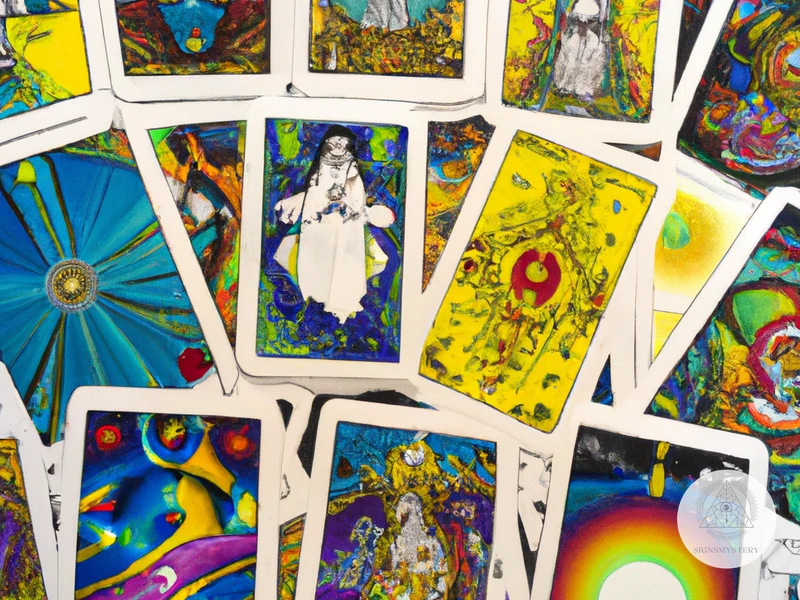
If you’re new to the Wild Unknown Tarot deck, getting started can be both exciting and intimidating. With its unique and stunning artwork, the deck has become a favorite among tarot enthusiasts. However, diving into the world of tarot with this deck requires some preparation to fully appreciate its symbolism and meanings. In this section, we’ll explore some tips and tricks to help you get started with the Wild Unknown Tarot deck. We’ll cover the Major and Minor Arcana, court cards, and more to help you understand the basics of the deck. Whether you’re a seasoned tarot reader or a beginner, these insights will be helpful in building a strong foundation for reading with the Wild Unknown Tarot deck. For more information on the symbolism behind the deck, you can read our article on Wild Unknown Tarot Symbolism.
Explore the Major Arcana
When exploring the Major Arcana, it’s important to understand that these cards represent “big picture” themes and experiences in our lives. The Major Arcana consists of 22 cards, each with their own unique energy and symbolism. Here are some tips for exploring the Major Arcana:
- Take your time: Don’t rush through the Major Arcana. Take your time studying each card and reflecting on its meaning.
- Notice the details: The Wild Unknown Tarot deck is known for its intricate and detailed illustrations. Look closely at each card and notice the symbolism and imagery.
- Make connections: Look for connections between the cards and the themes in your own life. For example, if you draw The High Priestess, consider how intuition and inner wisdom are currently playing a role in your life.
- Refer to resources: Don’t be afraid to refer to resources like guidebooks or online articles for further insight into the Major Arcana. You can also check out our tips for working with the Wild Unknown Tarot deck for more guidance.
- Consider the reversals: When shuffling the deck, pay attention to any reversed cards that may come up. The reversal of a Major Arcana card can indicate a blockage or challenge in the corresponding area of your life.
By taking time to explore the Major Arcana cards, you can gain a deeper understanding of these powerful symbols and how they relate to your life journey. And if you want to learn more about the creator of the Wild Unknown Tarot deck, check out our interview with Kim Krans here.
Understand the Minor Arcana
Understanding the Minor Arcana is an essential part of mastering the Wild Unknown Tarot deck. The Minor Arcana cards represent the day-to-day trials and tribulations of life. They are divided into four suits: Wands, Cups, Swords, and Pentacles. Each suit is also associated with one of the four elements: fire, water, air, and earth, respectively.
Wands: The Wands suit represents energy, creativity, and passion. It is associated with the element of fire and can indicate a need for movement and action. This suit often appears in readings related to career or projects.
Cups: The Cups suit represents emotions, relationships, and intuition. It is associated with the element of water and can indicate a need for self-reflection and introspection. This suit often appears in readings related to love or personal growth.
Swords: The Swords suit represents conflict, decision-making, and mental clarity. It is associated with the element of air and can indicate a need for assessment and negotiation. This suit often appears in readings related to conflict resolution or decision-making.
Pentacles: The Pentacles suit represents money, material possessions, and practicality. It is associated with the element of earth and can indicate a need for stability and grounding. This suit often appears in readings related to finances or career.
It is important to note that each suit contains ten numbered cards and four court cards, which are Page, Knight, Queen, and King, respectively. Each numbered card carries its own unique meaning and can provide more insight into a reading. The court cards represent personalities or situations and can indicate a need for identifying certain qualities or strengths in oneself or someone else.
Understanding the Minor Arcana and its symbolism can greatly enhance the accuracy and precision of a Wild Unknown Tarot reading. For more information on getting started with the Wild Unknown Tarot deck, check out our beginner’s guide or our article on exploring the Major Arcana.
Get Familiar with Court Cards
Court cards in the Wild Unknown Tarot deck represent personalities and energies that can help us understand people or situations we encounter in our lives. They often depict animals, each with their own unique characteristics and symbolism. Understanding court cards can be challenging, but it is an essential part of reading with the Wild Unknown Tarot deck.
Here are some tips on how to get familiar with Wild Unknown Tarot court cards:
- First, take a look at the image on the card and try to identify which animal is depicted. The animals used in the Wild Unknown Tarot deck are carefully chosen for their symbolism and energy. For example, the Queen of Swords is represented by a barn owl, which is known for its keen intelligence and sharp vision.
- Next, consider the position of the animal on the card. Is it standing still, in motion, or interacting with other elements on the card? This can provide clues to the card’s meaning.
- Pay attention to the suit of the card. Each suit (wands, cups, swords, and pentacles) has its own set of meanings and associations. The court cards of a particular suit usually relate to themes within that suit.
- Don’t be afraid to consult a guidebook or online resource for additional information on the court cards. However, keep in mind that the meanings provided are just a starting point, and it’s important to use your intuition when interpreting the cards.
By becoming familiar with court cards, you can gain insight into the people and energies that influence your life. Take some time to study and meditate on these cards to deepen your understanding of the Wild Unknown Tarot deck.
If you want to learn more about the Wild Unknown Tarot deck, you can read about the minor arcana or compare it to other popular tarot decks in our article Wild Unknown Tarot vs. Popular Decks. You can also learn about cleansing and charging your deck for optimal energy in Cleansing and Charging Your Wild Unknown Tarot, or connecting with the spirit animals in the deck in Connecting with Spirit Animals in the Wild Unknown Tarot.
Reading with Wild Unknown Tarot Deck
As you become more familiar with the Wild Unknown Tarot deck, you’ll want to begin using it for readings. The deck’s unique artwork and symbolism provide a powerful tool for exploring the depths of the human psyche and gaining insights into the past, present, and future. But where do you start? How do you begin to interpret the cards and use them to gain meaningful insights? In this next section, we will discuss the key steps to take when using the Wild Unknown Tarot deck for readings, including shuffling techniques, choosing spreads, interpreting the cards, and more.
Shuffling the Deck
Before diving into a tarot reading with the Wild Unknown deck, it’s essential to understand how to properly shuffle the deck. The shuffling process helps to clear any energy from previous readings, allowing for a fresh and accurate interpretation of the cards. Below are some tips to follow when shuffling the Wild Unknown Tarot deck:
| 1. Clear Your Mind: | Before shuffling the deck, take a few deep breaths and clear your mind of any distractions. This will allow you to connect with your intuition and focus on the energy of the cards. |
| 2. Shuffle Intuitively: | Shuffle the cards in a way that feels natural and intuitive to you. Some people prefer to shuffle the cards by splitting the deck into two and riffle shuffling, while others prefer to shuffle the cards in their hands. Experiment with different shuffling methods until you find one that feels comfortable and effective. |
| 3. Set Your Intention: | Before drawing your cards, set your intention for the reading. This can be a question you want answered, an area of your life you want guidance on, or simply a desire for clarity and insight. Setting a clear intention will help to focus the energy of the cards and give you a more accurate reading. |
| 4. Cleanse Your Deck: | After shuffling, it’s a good idea to clear any energy from the deck. You can do this by smudging the cards with sage or palo santo, or by tapping them on a hard surface to release any excess energy. This step is optional but can help to ensure that your reading is accurate and clear. |
Shuffling the Wild Unknown Tarot deck is a simple but essential step in any reading. By following these tips, you’ll be able to clear your mind, connect with your intuition, and get a more accurate interpretation of the cards. Remember to trust your instincts and have fun with the process!
Choosing a Spread
When you’re ready to perform a reading with your Wild Unknown Tarot deck, the first step is to choose a spread. A spread refers to the pattern or arrangement of cards that will be used for the reading. There are numerous spreads to choose from, and each one has its own unique purpose and energy.
Here are a few commonly used spreads:
| Spread Name | Number of Cards | Purpose |
|---|---|---|
| Three-Card Spread | 3 | A simple yet versatile spread that can give insight into past, present, and future situations, as well as mind-body-spirit connections. |
| Celtic Cross | 10 | A traditional spread that offers insight into various aspects of a situation, including past influences, obstacles, hopes and fears, and potential outcomes. |
| One-Card Draw | 1 | A quick and easy way to gain insight into a specific question or situation. |
| Relationship Spread | 6 | A spread designed to provide insight into the dynamics of a romantic partnership. |
When choosing a spread, it’s important to consider your intention for the reading and the specific questions or areas of life you want to focus on. Some spreads are better suited for general insight, while others are designed for specific topics such as career or relationships.
Don’t be afraid to experiment with different spreads to see what works best for you and your style of reading. Over time, you may also develop your own personalized spreads that speak to your unique intuitive and divinatory abilities. The most important thing is to approach each spread with an open mind and a willingness to learn and grow from the insights provided by the cards.
Interpreting the Cards
Interpreting the Cards
Once you have shuffled and chosen a spread, it’s time to interpret the cards. Each card in the Wild Unknown Tarot deck has a unique meaning and symbolism associated with it. Understanding these meanings can help you gain insight into the situations and questions you are seeking guidance on.
To help you interpret the cards, refer to the guidebook that comes with the deck. However, keep in mind that these meanings are just a starting point. The interpretation of each card can vary depending on the context of the question or situation and your own intuition.
One technique for interpreting the cards is to analyze the imagery and symbolism. Take note of the colors, animals, landscapes, and other elements present in the card. Consider how they relate to the question or situation and what emotions or ideas they evoke.
Another technique is to pay attention to the position of the card in the spread. For example, a card in the “past” position may represent a past event or influence that is still affecting the present. A card in the “future” position may represent a potential outcome or direction.
It’s important to approach each card with an open mind and without preconceived notions. Don’t let your personal biases or desires affect your interpretation. Instead, trust in the wisdom of the cards and the guidance they provide.
Below is a table outlining the basic meanings of each of the cards in the Wild Unknown Tarot deck:
| Card | Meaning |
|---|---|
| The Fool | Risk-taking, new beginnings, innocence |
| The Magician | Manifestation, resourcefulness, power |
| The High Priestess | Intuition, secrets, inner wisdom |
| The Empress | Nurturing, fertility, abundance |
| The Emperor | Authority, structure, control |
| The Hierophant | Spiritual guidance, tradition, institutions |
| The Lovers | Relationships, choices, harmony |
| The Chariot | Willpower, determination, victory |
| Strength | Inner strength, courage, endurance |
| The Hermit | Solitude, introspection, guidance |
| Wheel of Fortune | Cycles, change, destiny |
| Justice | Balance, fairness, consequences |
| The Hanged Man | Sacrifice, letting go, new perspective |
| Death | Transformation, endings, rebirth |
| Temperance | Moderation, balance, harmony |
| The Devil | Bondage, addiction, materialism |
| The Tower | Disaster, upheaval, revelation |
| The Star | Hope, inspiration, renewal |
| The Moon | Illusion, uncertainty, subconscious |
| The Sun | Contentment, vitality, success |
| Judgment | Awakening, rebirth, awareness |
| The World | Completion, fulfillment, wholeness |
Use this table as a reference, but always trust your intuition and personal connection to the cards when interpreting them.
Intuition vs. Book Meanings
When it comes to interpreting tarot cards, there are two main approaches: following the book meanings and using your intuition. Both methods can be valuable, and it’s important to find a balance between the two.
Using the Book Meanings: Tarot decks usually come with a guidebook that provides suggested interpretations for each card. These book meanings can be a helpful starting point, especially if you’re new to tarot or working with a deck for the first time. They can provide insight into the traditional symbolism and interpretations of each card, as well as offer guidance for specific spreads.
However, it’s important to remember that these book meanings are simply suggestions – not hard and fast rules. Every reader will have their own interpretation of each card, based on their own experiences and understanding of the tarot. It’s also worth noting that different decks may have slightly different interpretations or symbolism for each card.
Using Intuition: Your intuition is a valuable tool when reading tarot. It allows you to tap into your inner wisdom and interpret the cards in a way that is meaningful and relevant to you. When using your intuition, you may pick up on subtle details in the imagery, notice patterns between cards, or receive intuitive insights from your higher self or spirit guides.
One way to use your intuition is to let your eyes naturally rest on certain parts of the card, allowing your subconscious mind to pick up on details that may hold significance. You could also try meditating on the card’s imagery, or simply allowing your thoughts and impressions to flow freely as you observe the card.
Finding a Balance: While it’s important to trust your intuition, it’s also helpful to have a solid understanding of the book meanings and symbolism of the cards. This can provide a grounding influence and help you interpret the cards in a way that is both intuitive and logical.
Remember, there’s no “right” or “wrong” way to interpret tarot cards – it’s ultimately up to you to find a method that works best for you. Whether you choose to follow the book meanings, use your intuition, or a combination of the two, trust that your interpretations are valid and meaningful.
Astrology, Numerology, and Elemental Associations
Understanding the Astrology, Numerology, and Elemental Associations of each card in your Wild Unknown Tarot Deck can add depth and complexity to your readings. Each card in the deck is associated with one of the 12 zodiac signs, a numerological value, and an element (either water, air, fire, or earth).
Using an astrological lens to interpret the cards can give you additional insight into the overall meaning of the reading. For example, if you draw The Sun card, which is associated with the zodiac sign of Leo, you may want to consider themes of creativity and self-expression. The Moon card, associated with the zodiac sign of Pisces, could indicate a need to pay attention to your intuition and dreams.
Looking at the numerology of each card can also be helpful. Each card is associated with a number, and those numbers can be reduced to a single digit by adding them together. For example, The Magician card is associated with the number 1, which represents beginnings and new opportunities. The Wheel of Fortune card is associated with the number 10 (1+0), which represents completion and cycles.
Finally, the elemental associations of each card can add depth and texture to your readings. Cards that are associated with the element of water (such as The Moon or The Star) may indicate emotions and intuition, while cards associated with earth (like The Devil or The Hierophant) could represent material concerns or practical matters.
Here’s a table to help you keep track of the astrological, numerological, and elemental associations of each card:
| Card | Zodiac Sign | Numerology | Elemental Association |
|---|---|---|---|
| The Fool | Uranus | 0 | Air |
| The Magician | Mercury | 1 | Air |
| The High Priestess | Moon | 2 | Water |
| The Empress | Venus | 3 | Earth |
| The Emperor | Aries | 4 | Fire |
| The Hierophant | Taurus | 5 | Earth |
| The Lovers | Gemini | 6 | Air |
| The Chariot | Cancer | 7 | Water |
| Strength | Leo | 8 | Fire |
| The Hermit | Virgo | 9 | Earth |
| Wheel of Fortune | Jupiter | 10 (1+0) | Fire |
| Justice | Libra | 11 (1+1) | Air |
| The Hanged Man | Neptune | 12 (1+2) | Water |
| Death | Scorpio | 13 (1+3) | Water |
| Temperance | Sagittarius | 14 (1+4) | Fire |
| The Devil | Capricorn | 15 (1+5) | Earth |
| The Tower | Mars | 16 (1+6) | Fire |
| The Star | Aquarius | 17 (1+7) | Water |
| The Moon | Pisces | 18 (1+8) | Water |
| The Sun | Sun | 19 (1+9) | Fire |
| Judgement | Pluto | 20 (2+0) | Fire |
| The World | Saturn | 21 (2+1) | Earth |
As you become more familiar with the associations of each card, you can use them to create more nuanced and insightful readings.
Advanced Techniques
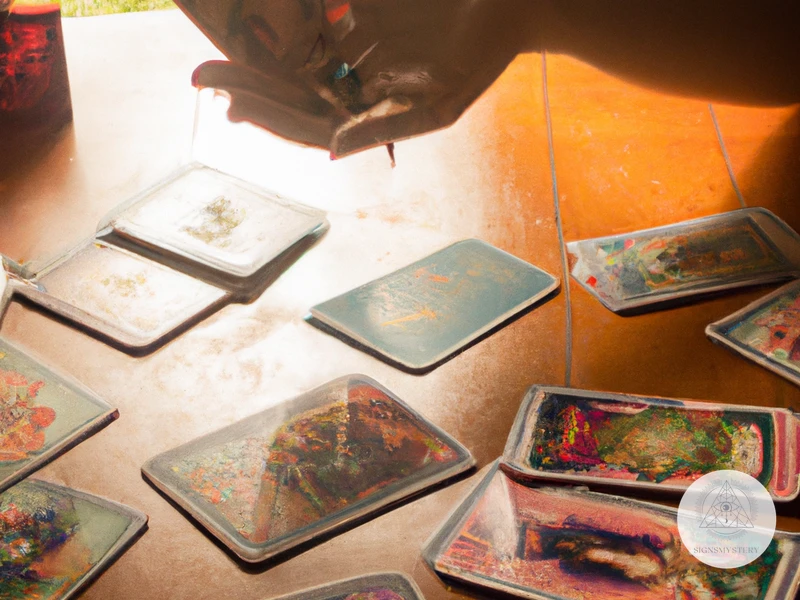
Now that you have become more comfortable with the basics of reading tarot with the Wild Unknown deck, it’s time to explore more advanced techniques. These techniques may be a bit more challenging and require extra focus and attention, but they can also offer a deeper level of insight and understanding. As you experiment with these techniques, you may find that your readings become more accurate, nuanced, and meaningful. So let’s dive into some powerful methods for taking your Wild Unknown tarot practice to the next level.
Reverse Card Meanings
When reading with the Wild Unknown Tarot deck, it’s important to understand the meaning of each card, including the reversed meanings. When a card appears reversed, it can indicate a blockage or resistance in the energy related to that specific card. Here are some tips for interpreting reverse card meanings:
- Take note of your initial reaction: When a card appears reversed, it can often evoke a different emotion or feeling compared to when it appears upright. Take note of your initial reaction to the card and how it differs from the upright meaning.
- Consider the context: Just like with upright card meanings, the context of the reading is important when interpreting reversed card meanings. Take into account the cards surrounding the reversed card and the question being asked.
- Look for themes: When multiple cards in a spread appear reversed, it can indicate a common theme of resistance or challenges. Look for patterns and similarities among the reversed cards to gain a deeper understanding of the situation.
- Explore the shadow side: Reversed card meanings can offer insight into the shadow side of the energy related to that card. Take time to reflect on the potential negative aspects of the card and how they may be impacting the situation at hand.
- Flip the meaning: In some cases, the meaning of a reversed card may simply be the opposite of the upright meaning. For example, the reversed Ace of Swords could represent confusion or a lack of mental clarity instead of new beginnings and intellectual breakthroughs.
By considering these tips, you can start to develop a deeper understanding of the reversed meanings of the Wild Unknown Tarot deck. Remember, the cards are meant to be interpreted as a whole and
Subscribe to Our Newsletter
Sign up to receive the latest news and updates.
Reading for Others
When it comes to reading tarot cards for others, there are a few things to keep in mind to ensure a successful experience. Firstly, it’s important to have a clear intention and to set boundaries in terms of the questions that will be asked. This helps to create a safe space for both the reader and the querent (the person receiving the reading).
Preparing for the Reading
Before starting the reading, take a moment to connect with your deck and ask for guidance and clarity. It can be helpful to cleanse the deck beforehand, either through shuffling or with a cleansing technique like smudging. Set the scene by creating a comfortable and calming atmosphere – this could be as simple as lighting a candle or setting out a few crystals.
Approaching the Reading
During the reading, it’s important to stay focused and present with the querent. Take the time to listen deeply to their questions and concerns, and avoid getting sidetracked by your own biases or judgments. It can be helpful to ask clarifying questions or to invite the querent to share more about their perspective or situation.
Interpreting the Cards
When interpreting the cards, it’s important to remain open and curious. Avoid jumping to conclusions or making assumptions based on the surface level meaning of the cards – instead, take the time to explore their symbolism and how it relates to the querent’s situation. Remember that tarot is a tool for self-discovery and personal growth, and as such it’s not always about predicting the future or finding easy answers.
Providing Support and Follow-Up
After the reading, be sure to provide support to the querent if needed. This could be in the form of additional resources, referrals to other practitioners, or simply a listening ear. It can also be helpful to follow up with the querent a few days or weeks after the reading to check in on their progress and see if there are any further insights or questions that have come up.
| Key points for reading for others |
|---|
| Set clear intentions and boundaries |
| Connect with the deck and create a calming atmosphere |
| Listen deeply to the querent’s questions and concerns |
| Stay open and curious when interpreting the cards |
| Provide support and follow-up as needed |
Pairing Tarot with Oracle Cards
One advanced technique that can enhance your tarot readings is to pair the Wild Unknown Tarot deck with oracle cards. Oracle cards often have a different energy and tone than tarot cards, offering additional insights and perspectives to your readings.
Step 1: Choose an oracle deck that resonates with you and your intentions for the reading. You may want to select an oracle deck that has a similar theme or energy to the tarot deck you are using.
Step 2: Shuffle both decks separately, focusing your intention on the question or topic you want to explore.
Step 3: Choose a tarot spread, and lay out the cards as you normally would. Then, draw an oracle card and lay it in the center of your spread.
Step 4: Interpret the tarot cards as you normally would, paying attention to any connections or correlations with the oracle card at the center.
Step 5: Interpret the oracle card in relation to the tarot spread, and consider how its energy and message add depth and nuance to the reading.
Keep in mind that the oracle card should be used as a tool to complement and enhance your tarot reading, rather than overpower or dominate it. Use your intuition to determine the relevance and significance of the oracle card in each reading.
Some popular oracle decks that pair well with the Wild Unknown Tarot include the Wisdom of the Oracle by Colette Baron-Reid, the Spirit Animal Oracle by Colette Baron-Reid, and the Angel Answers Oracle by Doreen Virtue and Radleigh Valentine.
Pairing the Wild Unknown Tarot deck with oracle cards can add a new level of depth and complexity to your readings, allowing for a nuanced exploration of different energies and perspectives.
Cleansing and Storing Your Deck
As you start to develop a deeper connection with your Wild Unknown Tarot deck and use it for readings, it’s essential to take good care of it. Cleansing and storing your deck properly can keep the energy clear and enhance your readings. But with so many cleansing and storing methods available, it can be overwhelming to know where to start. In this section, we’ll explore some different techniques for cleansing your deck and share tips on how to store it safely. So, let’s dive in and discover how to keep your Wild Unknown Tarot deck in top condition.
Cleansing Techniques
When it comes to tarot cards, many people believe that they hold energy and should be cleansed regularly to maintain their optimal power. If you’re using the Wild Unknown Tarot deck, it’s important to know the different techniques you can use to cleanse your cards. Here are some of the most popular and effective methods:
| Cleansing Technique | Description |
|---|---|
| Saging: | Saging is one of the most popular ways to cleanse tarot cards. To do this, light a sage stick and allow the smoke to envelop the cards. Be sure to fan the smoke over each card, so they’re all equally cleansed. |
| Candle Flame: | Hold each card over a candle flame briefly while focusing on your intention to clear the energy from the cards. |
| Crystal Cluster: | Place your Wild Unknown Tarot deck on a crystal cluster overnight. Clear quartz, amethyst, and selenite are all popular choices for cleansing and charging tarot cards. |
| Moonlight: | Leave your deck in a place where it will be exposed to the light of the full moon. The energy of the moon will remove any negative energy from the cards and restore them to their natural state of balance. |
| Sea Salt: | Place your deck in a cotton bag along with a handful of sea salt. Leave it overnight, and the sea salt will absorb any negative energy from the cards. |
It’s always a good idea to cleanse your Wild Unknown Tarot deck when it comes into your possession, and then periodically afterward. A good rule of thumb is to cleanse it whenever it starts to feel heavy or if you’ve used it for a particularly intense or emotionally charged reading. With the right cleansing technique, you’ll keep your cards functioning at their highest potential.
Storing Methods
When it comes to storing your Wild Unknown Tarot deck, you want to make sure it is protected from damage and negative energy. Here are some methods for storing your deck:
| Method | Description |
|---|---|
| Cloth Bag | A cloth bag is a simple and affordable option for storing your deck. Choose a fabric with natural fibers, like cotton or silk, to allow the cards to breathe. Avoid synthetic materials as they can hold onto negative energy. |
| Wooden Box | A wooden box is a great option for protecting your deck from physical damage. Look for one with a snug fit to prevent the cards from shifting around. You can also decorate the box to personalize it. |
| Glass Jar | A glass jar with a tight-fitting lid can not only protect your deck but also display it beautifully. Choose a size that fits your deck snugly and avoid storing it in direct sunlight to prevent fading. |
| Altar | If you have an altar, you can place your deck on it as a way to honor and connect with the cards. This can also help keep it safe from physical damage, but be sure to keep it away from candles and incense. |
No matter which method you choose, it’s important to keep your deck in a safe and positive space. Avoid storing it near electronics, like your phone or computer, as they can emit negative energy. And remember to cleanse your deck periodically, especially after lending it to others or doing a particularly heavy reading, to keep it energized and ready for use.
Conclusion
As we come to the end of this article, we hope that you have gained a deeper understanding of the Wild Unknown Tarot Deck and how to read it with confidence.
Remember, the key to successful tarot readings is practice and intuition. While it’s important to be familiar with the meanings of the cards, it’s equally important to trust your instinct and allow yourself to be guided by the messages and symbols that appear in your readings.
Whether you’re a beginner or an experienced reader, there is always something new to learn when it comes to tarot. So keep exploring different spreads, techniques, and associations, and don’t be afraid to experiment with different decks and tools to find what works best for you.
Lastly, don’t forget to take care of your tarot deck by regularly cleansing and storing it properly. By treating your deck with care and respect, you’ll develop a deeper connection with it and receive even more accurate and insightful readings.
So go forth, tarot enthusiast, and embrace the mystery and magic of the Wild Unknown Tarot Deck!
Frequently Asked Questions
What makes the Wild Unknown Tarot deck unique?
The Wild Unknown Tarot deck is known for its stunning hand-drawn artwork and use of natural symbolism, making it a popular choice for nature lovers and those drawn to a more mystical aesthetic.
What is the difference between the Major and Minor Arcana cards?
The Major Arcana cards represent major life events and spiritual lessons, while the Minor Arcana cards focus more on everyday experiences and daily influences.
Do I need to be familiar with astrology or numerology to use this deck?
No, while the deck does include astrological and numerological associations, it is not necessary to have extensive knowledge in these areas to read the cards effectively.
How should I cleanse my Wild Unknown Tarot deck?
There are various methods for cleansing your deck, including smudging with sage, placing the deck in moonlight, or using crystals such as clear quartz or selenite. Choose a method that resonates with you and your beliefs.
Can I use the Wild Unknown Tarot deck for readings for others?
Yes, the deck can be used for readings for others. However, it is important to remember to approach the reading with respect and a desire to offer guidance and insight, rather than simply telling the person what they want to hear.
Do I need to do a specific spread for each reading?
No, while there are traditional spreads such as the Celtic Cross, you can also create your own spread or simply draw cards and interpret them individually. It is important to choose a method that feels comfortable and natural for you.
Can I use the Wild Unknown Tarot for daily guidance or is it only for major life events?
The Wild Unknown Tarot can be used for any type of guidance or insight, from everyday experiences to major life events.
How can I connect with my intuition when using the Wild Unknown Tarot?
One way to connect with your intuition is to focus on your breath and clear your mind before drawing and interpreting the cards. You can also try meditating or journaling to deepen your connection with your inner voice.
How do I know if a card has a reversed meaning?
Generally, if a card is drawn upside down or reversed, it is said to have a different or opposite meaning than if it were drawn upright. However, it is important to remember that the meaning can vary depending on the individual reader and their interpretation.
Is it okay to store my Wild Unknown Tarot deck with other decks or should I keep it separate?
It is okay to store your Wild Unknown Tarot deck with other decks, but it is important to keep it protected in a cloth or box to prevent mixing energies with other decks.



